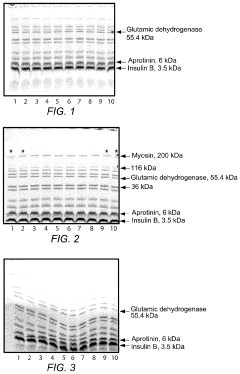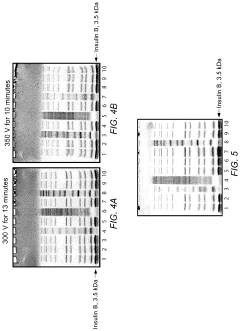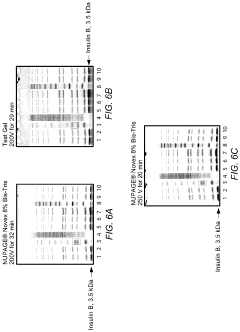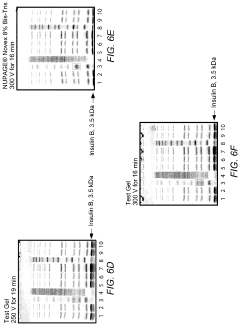How to Achieve Faster Results in Gel Electrophoresis?
Gel Electrophoresis Acceleration: Background and Objectives
Gel electrophoresis has been a cornerstone technique in molecular biology since its inception in the 1960s. This method, which separates molecules based on their size and electrical charge, has found widespread applications in DNA, RNA, and protein analysis. As research demands have grown, so too has the need for faster and more efficient electrophoresis techniques.
The primary objective of accelerating gel electrophoresis is to reduce the time required for sample separation while maintaining or improving resolution. This goal is driven by the increasing throughput demands in genomics, proteomics, and diagnostics. Faster results can significantly impact various fields, from basic research to clinical applications, by enabling quicker decision-making and more rapid experimental iterations.
The evolution of gel electrophoresis techniques has seen several key developments aimed at speed enhancement. These include the introduction of pulsed-field gel electrophoresis (PFGE) for separating large DNA molecules, the development of capillary electrophoresis for high-resolution separations, and the advent of microfluidic devices for miniaturized, rapid analyses.
Current challenges in accelerating gel electrophoresis include maintaining separation quality at higher speeds, managing heat generation, and ensuring compatibility with existing laboratory workflows. Researchers are exploring various approaches to address these issues, such as optimizing gel compositions, developing novel electrode designs, and implementing advanced cooling systems.
The quest for faster gel electrophoresis results is closely tied to broader trends in life sciences research, including the push for high-throughput screening, personalized medicine, and real-time diagnostics. As such, advancements in this area have the potential to impact a wide range of applications, from genetic testing to drug discovery.
Achieving faster results in gel electrophoresis requires a multidisciplinary approach, combining innovations in materials science, electrical engineering, and molecular biology. This convergence of disciplines presents both challenges and opportunities for researchers and technology developers in the field.
As we explore methods to accelerate gel electrophoresis, it is crucial to consider not only the speed of separation but also factors such as cost-effectiveness, ease of use, and scalability. These considerations will play a vital role in determining the adoption and impact of new technologies in both research and clinical settings.
Market Demand for Rapid Gel Electrophoresis Techniques
The market demand for rapid gel electrophoresis techniques has been steadily increasing in recent years, driven by the growing need for faster and more efficient molecular biology research and diagnostic processes. This demand is particularly pronounced in fields such as genomics, proteomics, and clinical diagnostics, where time-sensitive analyses are crucial.
In the research sector, academic and pharmaceutical laboratories are constantly seeking ways to accelerate their experimental workflows. Faster gel electrophoresis techniques allow researchers to process more samples in less time, leading to increased productivity and potentially faster scientific discoveries. This is especially important in high-throughput screening applications and large-scale genomic studies.
The clinical diagnostics market is another significant driver for rapid gel electrophoresis techniques. With the increasing emphasis on personalized medicine and point-of-care testing, there is a growing need for quick and accurate molecular diagnostic tools. Faster gel electrophoresis methods can significantly reduce turnaround times for genetic tests, enabling quicker patient diagnoses and treatment decisions.
In the biotechnology and pharmaceutical industries, the demand for rapid gel electrophoresis is fueled by the need for efficient quality control processes. These industries require fast and reliable methods to analyze the purity and integrity of nucleic acids and proteins during various stages of product development and manufacturing.
The global market for electrophoresis equipment and supplies, which includes gel electrophoresis, is expected to continue its growth trajectory. This growth is attributed to factors such as increasing research and development activities in the life sciences sector, rising prevalence of chronic diseases, and technological advancements in electrophoresis techniques.
Emerging markets in Asia-Pacific and Latin America are showing significant potential for growth in the rapid gel electrophoresis market. These regions are experiencing increased investment in life sciences research and healthcare infrastructure, driving the demand for advanced molecular biology tools.
However, the market demand is not without challenges. There is a constant pressure to develop even faster and more sensitive techniques while maintaining or improving accuracy. Additionally, there is a growing interest in alternatives to traditional gel electrophoresis, such as capillary electrophoresis and microfluidic devices, which may impact the future market dynamics.
In conclusion, the market demand for rapid gel electrophoresis techniques is robust and multifaceted, driven by the needs of various sectors within the life sciences and healthcare industries. The continued focus on speed, efficiency, and accuracy in molecular analysis ensures that this demand will likely persist and evolve in the coming years.
Current Challenges in Gel Electrophoresis Speed
Gel electrophoresis is a fundamental technique in molecular biology, widely used for separating and analyzing DNA, RNA, and proteins. However, the speed of this process has long been a bottleneck in many research and diagnostic applications. The current challenges in gel electrophoresis speed stem from several interconnected factors that limit the overall efficiency of the technique.
One of the primary challenges is the inherent physical limitations of the gel matrix. Traditional agarose and polyacrylamide gels, while effective for separation, impose significant resistance to the movement of molecules. This resistance increases with the size of the molecules being separated, leading to longer run times for larger DNA fragments or proteins. The gel concentration, which is crucial for resolution, also impacts speed; higher concentrations provide better separation but at the cost of slower migration rates.
Another significant challenge is the heat generation during electrophoresis. As electric current passes through the buffer and gel, it generates heat, which can cause band distortion, sample degradation, and even gel melting. To mitigate these effects, lower voltages are often used, which in turn increases the overall run time. This trade-off between speed and heat management represents a major hurdle in accelerating the process.
The buffer system used in gel electrophoresis also plays a critical role in determining the speed of the process. While standard TBE (Tris-Borate-EDTA) and TAE (Tris-Acetate-EDTA) buffers are widely used, they may not be optimal for rapid separations. The ionic strength and pH of the buffer can significantly affect the migration rate of molecules and the overall efficiency of the separation.
Sample preparation and loading techniques present additional challenges to achieving faster results. The time required for sample preparation, including DNA extraction and purification, can be substantial. Moreover, the manual process of loading samples into gel wells is time-consuming and prone to human error, which can lead to inconsistencies and the need for repeat runs.
The detection and visualization methods used in gel electrophoresis also contribute to the overall time required for analysis. Traditional staining techniques, such as ethidium bromide staining, add significant time to the process. While pre-staining methods exist, they can affect the migration of molecules and may not be suitable for all applications.
Lastly, the interpretation and analysis of gel electrophoresis results often rely on manual processes, which can be time-consuming and subjective. The lack of standardized, automated analysis tools for gel images contributes to delays in obtaining final results and can impact the reproducibility of experiments across different laboratories.
Addressing these challenges requires a multifaceted approach, combining innovations in gel materials, buffer systems, electrophoresis equipment, and analysis techniques. The development of novel gel matrices with reduced resistance, optimized buffer compositions, and advanced cooling systems could significantly enhance the speed of gel electrophoresis without compromising resolution or safety.
Existing Strategies for Accelerating Gel Electrophoresis
01 Optimization of buffer composition
The speed of gel electrophoresis can be improved by optimizing the buffer composition. This includes adjusting the pH, ionic strength, and concentration of the buffer solution to enhance the separation of molecules. Specific additives or electrolytes can be incorporated to increase conductivity and reduce run time while maintaining resolution.- Optimization of buffer composition: The speed of gel electrophoresis can be improved by optimizing the buffer composition. This includes adjusting the pH, ionic strength, and concentration of the buffer solution. Specific additives can also be incorporated to enhance separation and reduce run time.
- Modification of gel matrix: Altering the gel matrix composition and structure can significantly impact electrophoresis speed. This may involve using different polymer concentrations, cross-linking agents, or novel gel materials to improve separation efficiency and reduce analysis time.
- Application of electric field: The speed of gel electrophoresis can be enhanced by optimizing the applied electric field. This includes adjusting voltage, current, and field strength, as well as implementing pulsed-field or alternating-field techniques to improve separation and reduce run time.
- Temperature control and cooling systems: Implementing effective temperature control and cooling systems can allow for higher voltage applications, resulting in faster electrophoresis. This may involve using specialized cooling devices or temperature-regulated buffer circulation systems.
- Miniaturization and microfluidic devices: Developing miniaturized and microfluidic electrophoresis devices can significantly reduce analysis time. These systems often incorporate novel channel designs, integrated electrodes, and advanced detection methods to achieve rapid separations.
02 Gel matrix modifications
Modifying the gel matrix can significantly impact electrophoresis speed. This involves altering the concentration, crosslinking density, or pore size of the gel to facilitate faster migration of molecules. Novel gel formulations or composite materials can be used to enhance separation efficiency and reduce analysis time.Expand Specific Solutions03 Electric field manipulation
Manipulating the electric field applied during gel electrophoresis can increase separation speed. This includes using pulsed field electrophoresis, alternating current, or gradient field techniques to optimize molecule migration. Advanced electrode designs or field-focusing methods can be employed to enhance separation efficiency and reduce run times.Expand Specific Solutions04 Temperature control and cooling systems
Implementing effective temperature control and cooling systems can allow for higher voltage applications, resulting in faster electrophoresis. This involves designing apparatus with improved heat dissipation capabilities, using thermoelectric cooling elements, or incorporating microfluidic channels for efficient temperature regulation during the separation process.Expand Specific Solutions05 Miniaturization and microfluidic devices
Developing miniaturized and microfluidic electrophoresis devices can significantly reduce analysis time. These systems often incorporate novel channel designs, integrated electrodes, and advanced detection methods to achieve rapid separations. Microchip-based electrophoresis platforms can offer high-throughput capabilities and faster results compared to traditional slab gel methods.Expand Specific Solutions
Key Players in Electrophoresis Technology
The gel electrophoresis market is in a mature stage, with a global market size estimated to be over $1 billion. The technology is well-established and widely used in research laboratories, biotechnology companies, and diagnostic centers. Key players like Life Technologies Corp., Bio-Rad Laboratories, and Agilent Technologies dominate the market, offering advanced systems and consumables. These companies continually innovate to improve speed and efficiency, addressing the demand for faster results. Emerging trends include the development of automated systems, miniaturization, and integration with other analytical techniques. While the core technology is mature, ongoing research focuses on enhancing resolution, reducing run times, and expanding applications in fields such as proteomics and genomics.
Beckman Coulter, Inc.
Bio-Rad Laboratories, Inc.
Innovative Approaches to Faster Gel Separation
- The development of electrophoretic systems and formulations that allow for higher field strengths up to 50% more than conventional systems, using a discontinuous buffer system with specific gel amine and ampholyte buffers, and a pH range of 5.5 to 7.5, enabling faster separation of proteins within 30 minutes or less, even at higher voltages.
- The development of novel electrophoretic systems and formulations that allow for higher field strengths up to 50% more than conventional systems, using a discontinuous buffer system with specific gel amine and ampholyte buffers, and a polyacrylamide electrophoretic separation gel with varying polyacrylamide and cross-linker concentrations, enabling faster separation while maintaining high resolution.
Safety Considerations in Rapid Gel Electrophoresis
As the pursuit of faster results in gel electrophoresis accelerates, it is crucial to address the safety considerations associated with rapid techniques. The increased speed and intensity of these processes introduce new risks that must be carefully managed to ensure the well-being of laboratory personnel and the integrity of research outcomes.
One primary safety concern in rapid gel electrophoresis is the heightened risk of electrical hazards. The use of higher voltages to achieve faster separation can lead to increased chances of electrical shock or equipment malfunction. To mitigate these risks, it is essential to implement robust safety protocols, including regular equipment maintenance, proper grounding of all devices, and the use of insulated tools when handling electrophoresis apparatus.
The generation of excess heat during rapid gel electrophoresis poses another significant safety challenge. Accelerated processes often result in higher temperatures within the gel and buffer system, which can lead to sample degradation, buffer evaporation, and potential burns if proper precautions are not taken. Implementing efficient cooling systems, such as circulating buffer chambers or external cooling units, is crucial to maintain safe operating temperatures and preserve sample integrity.
Chemical safety is of paramount importance in rapid gel electrophoresis techniques. The use of more concentrated buffers or alternative gel matrices to enhance separation speed may introduce additional chemical hazards. Proper handling, storage, and disposal of these materials are essential to prevent exposure and environmental contamination. Personal protective equipment (PPE), including gloves, lab coats, and safety goggles, must be worn at all times when working with these substances.
The potential for increased aerosol generation during rapid gel loading and extraction processes necessitates enhanced respiratory protection measures. The use of fume hoods or biosafety cabinets when handling potentially hazardous samples or volatile reagents can significantly reduce the risk of inhalation exposure. Additionally, proper training in aerosol-minimizing techniques, such as careful pipetting and gel loading, should be provided to all laboratory personnel.
Ergonomic considerations become more critical in rapid gel electrophoresis procedures due to the increased pace and potential for repetitive motions. Proper workstation design, including adjustable seating and equipment placement, can help reduce the risk of musculoskeletal injuries. Regular breaks and task rotation among laboratory staff can also alleviate the physical strain associated with prolonged periods of intense work.
In conclusion, while rapid gel electrophoresis techniques offer significant advantages in terms of time and efficiency, they also present unique safety challenges that must be addressed comprehensively. By implementing robust safety protocols, utilizing appropriate protective equipment, and maintaining a culture of safety awareness, laboratories can harness the benefits of faster electrophoresis methods while safeguarding the well-being of their personnel and the integrity of their research.
Cost-Benefit Analysis of Accelerated Techniques
Accelerating gel electrophoresis techniques offers significant advantages in terms of time and resource efficiency, but these benefits must be weighed against potential costs and drawbacks. This cost-benefit analysis aims to evaluate the various accelerated techniques available for gel electrophoresis, considering both their financial implications and their impact on result quality and reliability.
One of the primary benefits of accelerated gel electrophoresis techniques is the substantial reduction in processing time. Traditional methods can take several hours to complete, whereas accelerated techniques can yield results in as little as 15-30 minutes. This time savings translates directly into increased laboratory productivity, allowing for higher sample throughput and faster turnaround times for results. In research settings, this can accelerate the pace of scientific discovery, while in clinical diagnostics, it can lead to more rapid patient diagnoses and treatment decisions.
However, the implementation of accelerated techniques often requires investment in specialized equipment and reagents. High-voltage power supplies, pre-cast gels, and optimized buffer systems may come at a premium compared to standard electrophoresis setups. The initial capital outlay for these items can be substantial, particularly for smaller laboratories or those with limited budgets. It is essential to consider whether the increased throughput and time savings justify this upfront investment.
Another factor to consider is the potential impact on result quality. While many accelerated techniques claim to maintain or even improve resolution and band separation, there may be trade-offs in certain applications. For instance, some rapid methods may not be suitable for separating very large DNA fragments or may result in slightly reduced band sharpness. Laboratories must carefully evaluate whether the speed gains outweigh any potential compromises in resolution or accuracy for their specific applications.
Operational costs are another important consideration. Accelerated techniques often consume more power due to higher voltage requirements, which can lead to increased electricity costs. Additionally, specialized buffers and pre-cast gels used in rapid methods tend to be more expensive than traditional alternatives. However, these higher consumable costs may be offset by reduced labor costs and increased sample throughput.
From a broader perspective, the adoption of accelerated gel electrophoresis techniques can enhance a laboratory's competitiveness and reputation. Faster turnaround times can attract more clients or collaborators, potentially leading to increased revenue or funding opportunities. In academic settings, the ability to generate results more quickly can facilitate more rapid publication of findings, potentially leading to increased citations and academic impact.
In conclusion, the cost-benefit analysis of accelerated gel electrophoresis techniques reveals a complex interplay of factors. While the initial investment and ongoing operational costs may be higher, the potential for increased productivity, faster results, and enhanced competitiveness can provide significant long-term benefits. Laboratories must carefully consider their specific needs, budget constraints, and application requirements when deciding whether to adopt these accelerated methods. Ultimately, the decision should be based on a comprehensive evaluation of both tangible and intangible benefits against the associated costs and potential limitations.






